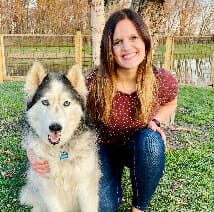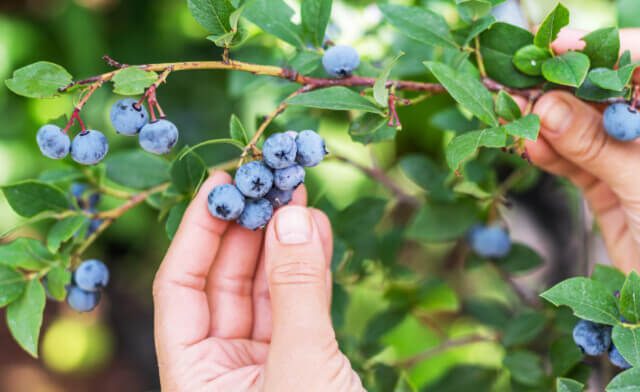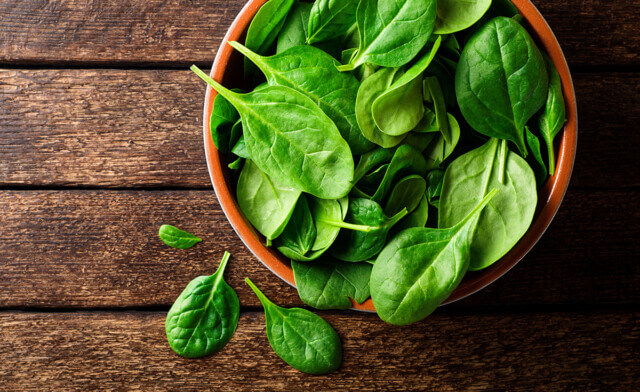Wet vs Dry Weight Management Dog Food
Have you noticed your pup packing on a few extra pounds recently? If so, it may be time to consider feeding a weight management recipe. Let’s look through some of the nutritious and still very delicious options to feed your pup to keep calories in check and the number on the scale where you want it!
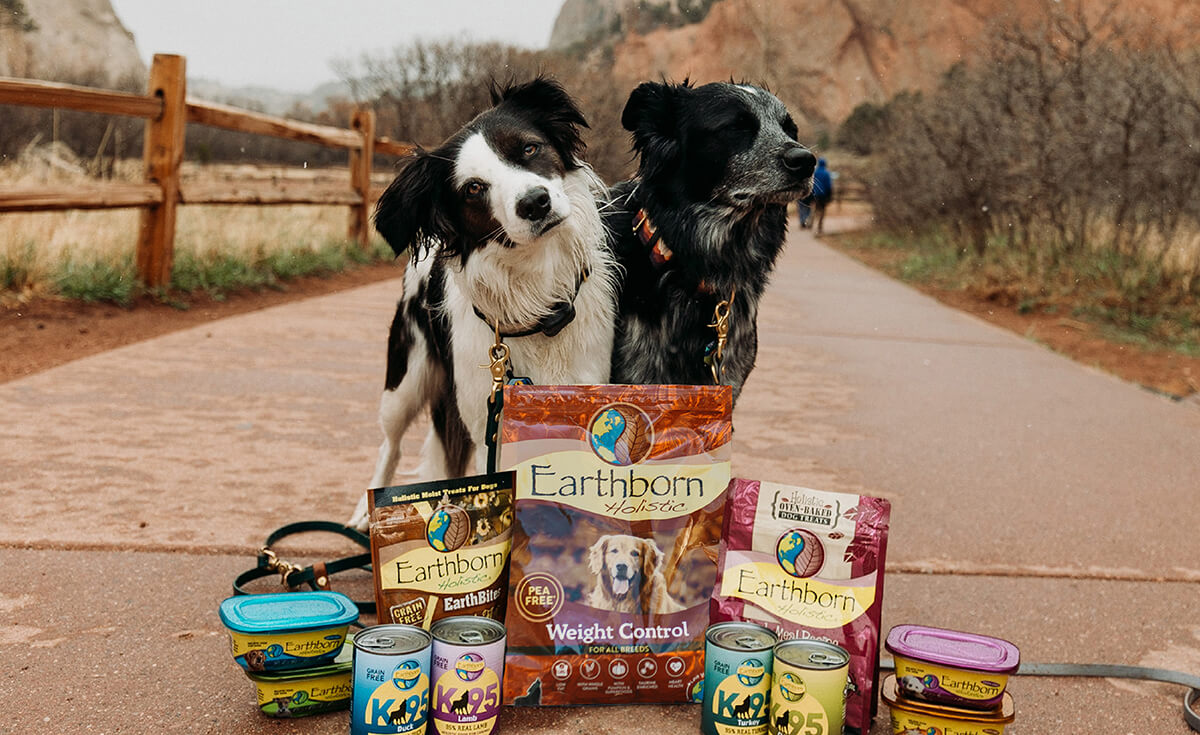
What Counts as Weight Management Dog Food?
There are several factors to look at when determining what a weight management dog food is. Weight management dog food is often referred to as ‘diet dog food’ because its focus is to keep your pet in shape while still providing them with all the nutrients they need. The calorie count plays an important role in tracking and maintaining weight loss. High calorie dog food will prevent weight loss. Therefore, feeding guidelines are helpful in determining how many calories are appropriate or how much food to feed.
Earthborn Holistic Weight Control is considered to be a low-fat dog food recipe. You will want to look for a high protein dog food, but make sure to choose one with a lean protein source. For example, turkey has a significant amount of protein, but has fewer dog calories per cup compared to other protein sources. Feeding your pup a reduced fat formula will be the key stepping stone to implementing your dog’s weight loss plan.
Wet or Dry Weight Management Dog Food
Wet food serves up a tasty option for your pup, but you may be wondering is wet food good for dogs? The simple answer is yes! Wet food can provide a highly palatable and nutritious meal for your dog and can be an easy way to add variety to your dog’s favorite bowl of kibble as a mixer or as a topper. From cans to convenient tubs, there are so many options and flavors to choose from that your dog is sure to love!
Wet dog food can also be a great option for senior dogs. A dog is usually classified as a “senior” if they are between 8 – 10 years old depending on their breed. At this age, dogs sometimes start to have issues chewing harder things like kibble and dog biscuits, so wet dog food is also a great senior dog food option in cases like these.
For senior dogs and overweight dogs, our Duke’s Din-Din Stew recipe is a great low calorie wet dog food option coming in at 209 kcal per container.
In your dog’s diet, dry dog food can still play a huge part in your dog’s weight loss journey. Our Weight Control recipe is a great and convenient weight management dog food option to help control your dog’s daily caloric intake while still getting the nutrition your canine pal needs to thrive.
Does your dog love the crunch of a kibble or the deliciousness of the meaty wet dog food? Let’s dive a little further into these two tasty options to find out the best food for weight loss to get your pet’s ideal body weight back. Spoiler… Your dog might even get to have a little bit of both!
Why You Can Trust Our Weight Management Dog Food
Our weight management dog food is crafted to keep your dog healthy by reducing fat while still providing the necessary nutrients. This recipe is perfect to assist your dog in losing some of the extra pounds you may be seeking as a pet parent. It is made of quality ingredients including Taurine for heart health, no artificial ingredients, and a blend of superfoods like pumpkin, blueberries, carrots and apples are the perfect addition to this low-fat dog food recipe.
Many pet parents seek real meat protein recipes in pet food. Whatever real meat you end up feeding, make sure it is leaner one. For example, turkey meal is the number one ingredient in our tasty Weight Control formula.
Wet Dog Food for Weight Management
A lot of pet parents get introduced to the different style of wet dog food recipes, (moist or semi moist dog foods) when their furry friend gets a little pickier with their dinner options or maybe their dog stopped eating dry food altogether! If this is the case, we recommend adding some wet food as a topper or mixer to your pup’s dry food to try to rekindle their love for kibble again.
One of the benefits of wet dog food as a topper is the increased palatability it adds to your pet’s food. If you have a picky pup who sometimes just doesn’t feel like eating, it’s worth a try to incorporate wet dog food into their meals every once in a while to get them excited about dinner time again. If your goal is weight loss, finding a lean protein or low-calorie protein option like turkey will help boost your dog’s weight loss efforts.
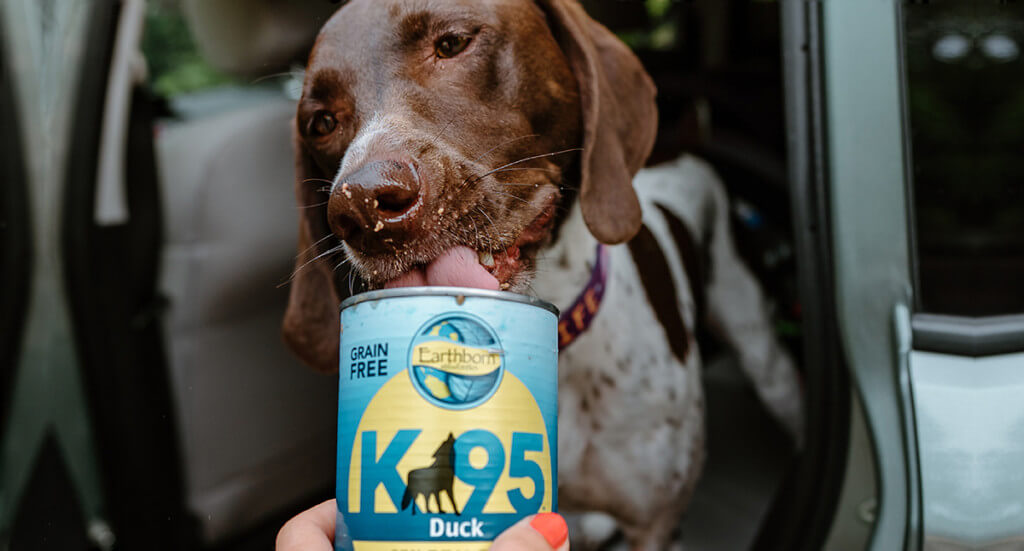
Can dogs eat wet food only? Of course! To know how much wet food to feed your dog, look at the feeding guidelines on the back label. For example, here are the feeding guidelines for our grain free wet dog food K95 Turkey recipe:
Feed adult dogs one 13 oz. container per 13-15 pounds of body weight daily, depending on activity level. When feeding with dry product, one container of K95 dog food replaces approximately ¾ cup dry pet food. Have clean, fresh water available at all times.
The feeding guidelines tell you how much wet dog food per day to feed based on your dog’s weight. Depending on how large your dog is, you may need to feed multiple cans or tubs a day. This is where eating only moist food can get a little pricier for the pet parent–especially if you have a larger dog with a big appetite!
Is wet food bad for dogs’ teeth? It depends. The crunchy texture of dry kibble or oven-baked biscuits can help remove tartar buildup on your pup’s teeth naturally, whereas wet food is a delicious option without the crunch that can sometimes get stuck and create buildup on teeth.
According to PetMD, almost 90% of dogs will have developed some form of periodontal disease by 2 years of age. This means it’s super important to consult with your veterinarian or the doggy dentist if you notice any issues with your dog’s oral health.
That being said, if you have a healthy dental routine in place like brushing teeth regularly and yearly cleanings then it shouldn’t matter if your dog prefers the crunch of a kibble or the meaty wet food option.
If you are looking for your dog to maintain or lose weight, it’s best to avoid the high calorie wet dog food options at this time. As mentioned earlier, our Duke’s Din-Din Stew recipe is a good low-calorie option along with our Lily’s Gourmet Buffet in Sauce and our K95 Duck wet dog food.
If you choose to feed wet food, it’s important to not let it sit out for more than 2 hours. After opening, transfer any unused portion to a container with a tight lid, or seal well with plastic wrap. The wet food can be kept for up to 4 days in the refrigerator.
Dry Dog Food for Weight Management
Dry dog food is a very popular choice for pet parents because it has a good shelf-life and easy storage, it‘s convenient to feed and it combines healthy ingredients into a crunchy, complete and balanced diet for your pet. Plus, it can be a more economical solution if you have larger or multiple dogs.
When looking for a good low fat dog food option, you will also want to look for a recipe that has a lean protein like turkey. Other proteins are often high in saturated fats and turkey specifically is a low-calorie protein, making it great for weight loss.
Once you’ve found the right weight management dry dog food recipe for your dog, please keep in mind portion control and portion size when feeding your dog. Controlled feeding is also recommended to monitor the amount of calories your dog ingests on a daily basis. Be sure to discuss your plan with your veterinarian to ensure your dog is getting the proper amount of nutrition to stay healthy while still meeting your weight loss goals.
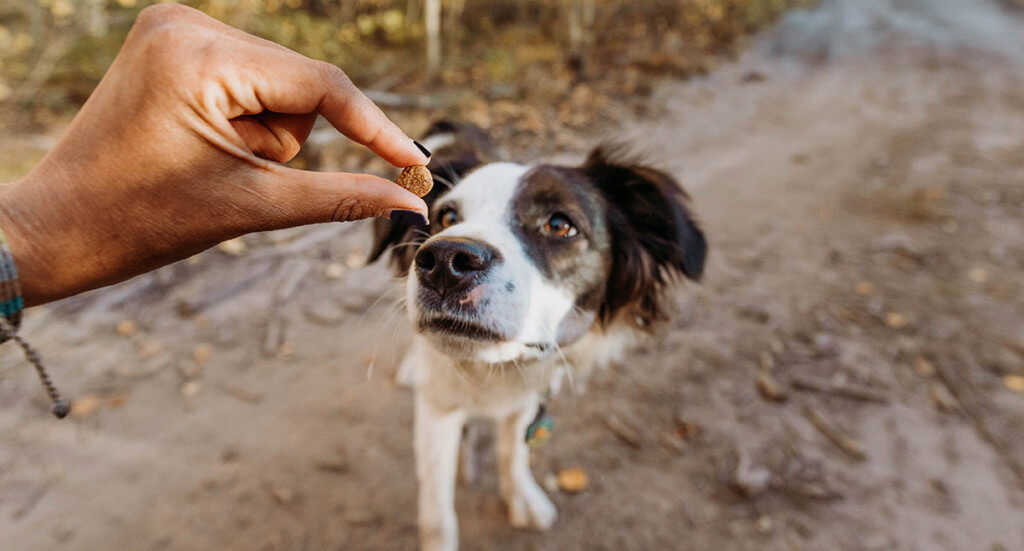
Storing Weight Management Dog Food
Once you find the right weight management dog food, you must make sure to properly store it. Doing so will help the dog food shelf life of the product. It is important to note the differences between storing dry dog food and wet dog food.
Generally, dry dog food shelf life is significantly longer than wet food. Earthborn Holistic dry dog food comes in sealable bags that aim to make storing easier. Storing wet dog food requires a few extra precautions. Wet food should typically not set out for more than two hours. Though, leftovers can last a few days in the refrigerator with a can cover to seal them.
If you are completely done feeding your pup one of our Earthborn Holistic recipes, make sure to take the recyclable bags made of green polyethylene, a plant-based plastic, to your nearest Earthborn ReBorn retailer.
Calories in Wet Dog Food vs Dry Dog Food
Now that we’ve discussed both food options, how do the dog food calories per cup in wet dog food compare to dry dog food? If you take our Weight Control recipe as an example, it contains 315 kcal/cup whereas our K95 Duck recipe contains 330 kcal/can. This is where the feeding guidelines, which includes a full list of ingredients and guaranteed analysis on the back of the packaging come into play. It’s important to note though that while feeding guidelines can be a great starting point, they’re not meant to replace advice from your vet so be sure to check with them, too.
Let’s use my dog Brody as an example. Brody is approximately a 60-pound Siberian Husky and according to the feeding guidelines on our high-quality grain free Weight Control recipe, which is our low calorie dog food option, it’s suggested to feed him 4 cups each day.
For our K95 canned dog food recipes, it’s suggested to feed 1 can for every 13 – 15 pounds of body weight so I would want to feed him 4 cans daily. For our Duke’s Din-Din recipe, it’s suggested to feed 1 tub per 8 – 10 pounds of body weight, so I would want to feed him 6 tubs.
Let’s take a look at which option offers the lowest amount of calories for the day:
Suggested daily feeding guidelines for Brody (60 lb. dog)
- 6 tubs of Duke’s Din-Din Stew = 1254 kcal/day
- 4 cups of Weight Control = 1260 kcal/day
- 4 cans of K95 Duck = 1320 kcal/day
According to the calculations above, my lowest calorie options would be Duke’s Din-Din Stew and then coming in at a close second would be our Weight Control dry dog food recipe!
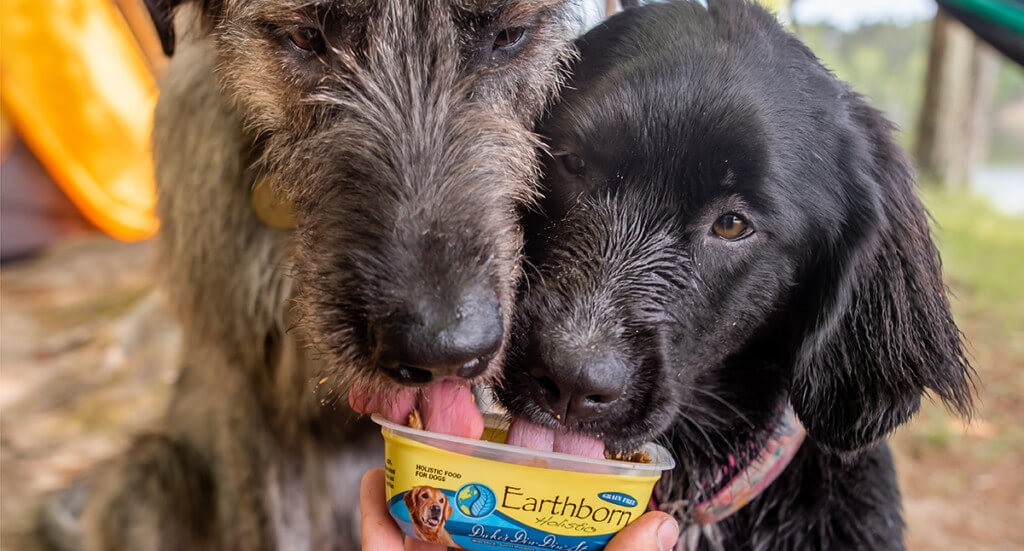
So now what does kcal mean exactly? Calories in dog food are measured in kilocalories, or “kcal.” That being said, it’s important to note that 1 kilocalorie in dog food is not 1,000 calories.
According to the American Association of Feed Control Officials (AAFCO), “Though it sounds complicated, the requirement that all pet food labels express calorie statements in terms of kilocalories per kilogram of product as fed makes it easier to compare similar products. A kilocalorie is the same as a calorie (aka a big calorie or food calorie). It means the same thing as a calorie on a human food label, but is a more scientifically accurate term.”
Typically on a dog food label, you’ll find something like “315 kcal/cup.” So, this does not mean 315,000 calories because the two units of measurement are not interchangeable. Instead, it just means there’s 315 kilocalories, 315 food calories, or 315 dog calories, per cup.
Use the feeding guidelines on your dog food packaging as a starting point, but ideally you’ll want to visit your local vet to discuss your dog’s weight concerns and come up with a weight loss plan together that will take into account breed, age, metabolism, body condition, activity level, environment, etc. If you determine the recommended calories your dog needs each day to lose weight you can use the information above to tailor a plan specific to your furry friend.
Ingredients to Avoid in Weight Management Dog Food
We’ve talked about what to look for in dog food for weight loss, but let’s also take a look at the ingredients you should avoid in dog food.
Artificial colors are best to avoid in pet foods because it’s an ingredient that doesn’t necessarily need to be added to the recipe. It is only added to provide a desired appearance and not usually added for any nutritional value. While it’s rare, artificial colors can also be a concern for pet parents who have dogs with allergies.
BHA (butylated hydroxyanisole) and BHT (butylated hydroxytoluene) are synthetic additives that help to stabilize fats in different food products and prolong shelf life. These ingredients are “generally recognized as safe” for use by the FDA in limited quantities, but there have been rumors that these additives are linked to cancer and reproductive disorders. It is best to look for a food that uses more natural options like ascorbic acid or mixed tocopherols as a preservative.
Corn syrup is another ingredient to stay away from. While non-toxic, it does contain a very large amount of sugar. Just like humans, high intakes of sugar can lead to weight gain (the opposite of what we are hoping to accomplish here!), hyperactivity, and even diabetes.
MSG, monosodium glutamate, is used primarily as a flavor enhancer and provides no real benefit to your pet. Some pets and humans can also be allergic to this ingredient which adds another reason to avoid it.
White flour is a common household ingredient, but isn’t necessarily the best option for your pet. If you like making homemade treats for your dogs it’s best to opt for wheat or buckwheat flour since white flour is highly treated and lacks some of the same nutrients.
It’s also important to note that some dogs can have allergies to grains. If you know your dog has a grain intolerance, we do offer several grain-free moist treat and biscuit options that still offer that oven-baked taste without the need for white flour.
Carrageenan is used as a thickening agent to help bind ingredients together which helps aid in food consistency. This is most commonly found in canned, wet or moist dog or cat food. This ingredient has grown in controversy over the years with many people believing it can cause stomach issues and in more extreme cases, cancerous tumors.
Sodium nitrite is added to dog food to help preserve the food and also to help keep the food’s color. It’s a chemical preservative that is regulated by the FDA and is considered harmful in large doses.
Artificial sweeteners such as xylitol can be found in chewing gum, toothpastes, and other sugar-free products and can be highly toxic for dogs. Some peanut butters even contain xylitol so it’s always important to check the ingredient label. Even in small amounts the consumption of xylitol can cause a sudden drop in your dog’s blood sugar and can lead to seizures, liver failure, and death.
If you find any of these ingredients in your dog food, it’s important to consult with your veterinarian, not just Google, to figure out if a change in food is necessary.
Changing to a Weight Loss Dog Food
If you’ve decided that weight management dog food is right for your pup, the next step is to actually make the switch. Even though you may be tempted to switch your dog’s food cold turkey, switching dog food without mixing over a period of time can lead to many side effects, including giving your dog an upset stomach after switching food. Upset stomachs equal an unhappy pup and an equally unhappy pet parent if a mess needs to be cleaned up.
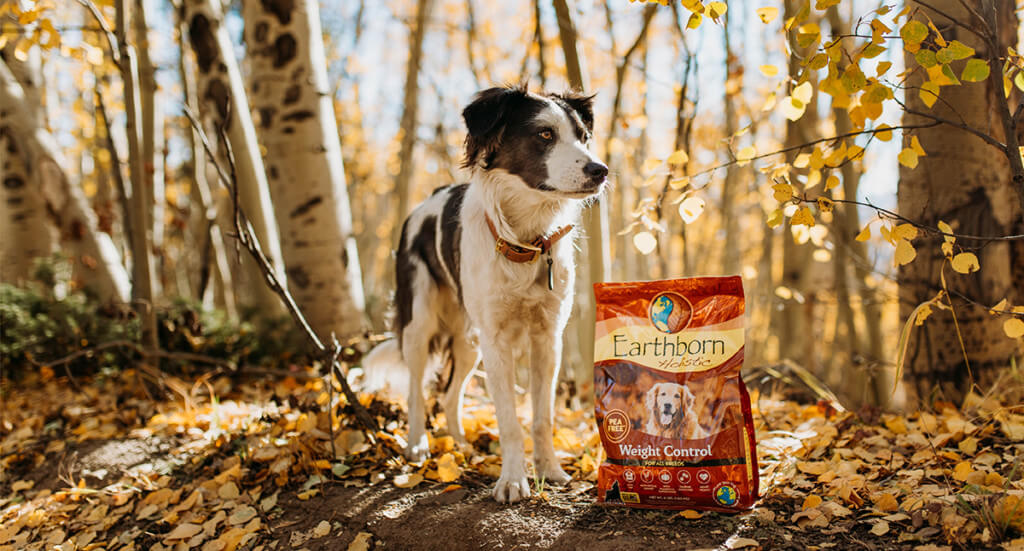
Once you start the transition, how long does it take for a dog to adjust to a new food? About seven days! For this reason, you’ll want to reference a dog food transition chart or this video to learn the proper way for how to transition dog food. Here is the recommended breakdown of the seven day switch:
- Days 1 & 2 – 25% new food, 75% old food
- Days 1 & 2 – 25% new food, 75% old food
- Days 3 & 4 – 50% new food, 50% old food
- Days 5 & 6 – 75% new food, 25% old food
- Day 7 – 100% new food
This allows your pup to grow familiar with their new food and it also helps alleviate issues that come from switching dog food. When changing dog food too quickly, symptoms like upset stomach can occur so switching dog food slowly over a period of a week (or two if your dog is especially prone to stomach issues) is always best.
One thing to note is to make sure you’re paying attention to the feeding guidelines on both food recipes to make sure you’re not overfeeding or underfeeding–there’s a chance you may need to go from two cups of one food to three cups of the other, for example, so how to change dog food in situations like these will vary slightly. You’ll just have to keep this in mind when determining the right ratio to feed.
If your dog’s a picky eater, you can also try adding in some moist food as a mixer or topper to make the kibble more palatable. However, mixing dry and wet dog food ratio must be considered to ensure you are keeping calories in check if your goal is weight loss. Be sure to reference the packaging to figure out the proper ratio.
For example, here are the feeding guidelines for our grain free wet dog food K95 Turkey recipe:
Feed adult dogs one 13 oz. container per 13-15 pounds of body weight daily, depending on activity level. When feeding with dry product, one container of K95 dog food replaces approximately ¾ cup dry pet food. Have clean, fresh water available at all times.
Keep this amount in mind when mixing your favorite dry food with your favorite wet food and you’ll be able to continue your pup’s weight loss journey while still having some variety at meal time.
You may also be wondering how to weigh a dog in order to know if your weight management routine is actually working. Most vet offices will allow you to stop by and weigh your pet for free, but make sure to call ahead and confirm this with your local vet first.
If you can physically lift your dog you can try weighing your dog at home. Digital scales work the best.
- Step on the digital scale and weigh yourself first. If you are like me and forget numbers relatively fast then you may want to write the number down.
- Pick up your dog and weigh yourself while holding your dog. Write down the weight!
- Now subtract “your weight” from “you and your dog’s total weight” and you have your dog’s final weight!
Mind-blowing technique, right? Now if you have a rather large dog that you can’t pick up without breaking your back you can also choose to invest in a dog scale to have at home. Dog scales can be relatively expensive so first decide if recording your dog’s weight frequently is important to you. If it is, then it’s worth the investment. If you plan on weighing your dog less frequently, then we recommend utilizing your local veterinarian.
Habits to Help with Weight Loss
Healthy habits are an important part of your dog’s weight loss journey. Besides nutrition, another key part of maintaining a healthy weight and establishing a healthy weight loss rate is exercise!
We have several dog exercise tips to help with weight loss. But how much exercise does my dog need? As a general rule most dogs should get around 30 minutes to two hours of physical activity each day, but a lot of that depends on their breed, age, and overall activity level.
The easiest way to start is to exercise at home. If you have access to a fenced-in yard, you can start simply by playing fetch, throwing the frisbee, engaging in tug-of-war with a rope toy, or playing hide and seek! Going for a walk around the neighborhood is another simple, but effective way to get a dog workout in. Besides the physical benefits, exercise and walking provides numerous mental health benefits as well.
If you don’t have access to a backyard or you are just looking for more social opportunities it might be a good idea to check out local dog parks, dog-friendly beaches, dog-friendly hiking trails, or join a local AKC dog sport group like agility or dock diving. In addition to exercise, these all offer great ways to bond with your dog and establish healthy fitness routines moving forward for both of you.
If your schedule doesn’t allow for dog sports or extensive daily walks, you can still get your dog up and moving while at home. Look into puzzle feeders or other enrichment toys that can get your dog up off the couch for a little bit. Pair these toys with low-calorie treats for a mini indoor workout for your dog.
Once you get a good exercise routine in place it’s important to continue streamlining your nutrition plan. When weight loss is a goal, table scraps must be kept to a minimum or eliminated. Table scraps, while delicious, can contain high amounts of calories and can also have ingredients that may not be appropriate for your dog to eat. Examples of foods that are toxic to dogs include grapes, raisins, peaches, plums, artificial sweeteners, macadamia nuts, and garlic.
It’s important to choose a complete and balanced recipe to feed your pup, such as our Weight Control recipe. Our weight management dog food is specially crafted to help keep your dog healthy and fit by reducing fat without reducing the necessary nutrients your pup needs.
This recipe is perfect to help your dog with their weight control or can even assist in helping to lose some extra pounds. It’s enriched with Taurine for heart health and is crafted without peas, lentils, or legumes. An added blend of superfoods like pumpkin, blueberries, carrots and apples are the perfect addition to this low-fat dog food recipe.
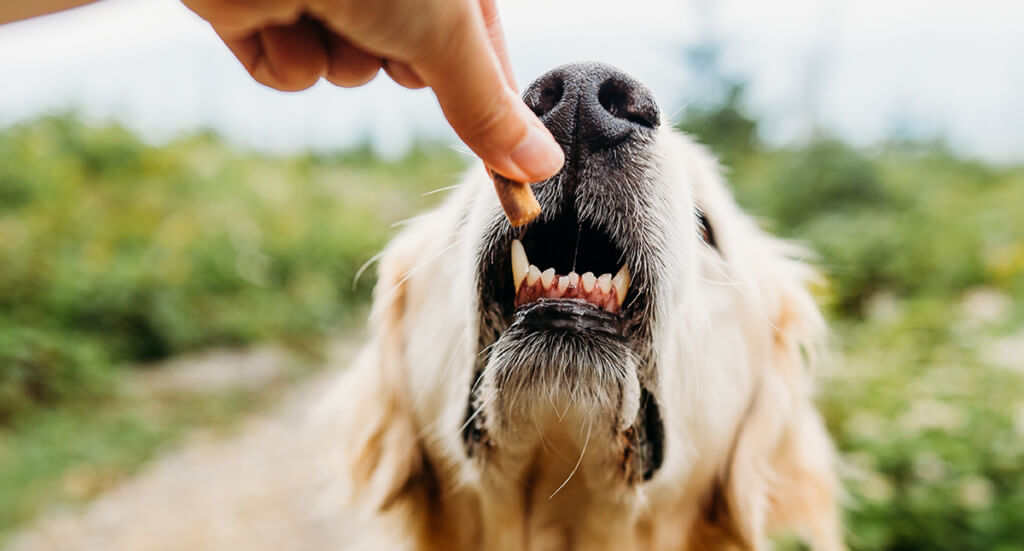
In addition to food, it’s common to ask if it’s still okay to feed your dog treats. If so, how many treats per day for a dog should you feed? Yes, it’s still okay to give your dog treats–but you have to be careful with the kind of treats and the quantity of treats you feed. You want to look for a treat that has a lower fat percentage and has a lower amount of calories per treat.
When figuring out the amount of treats you can give your dog, remember it’s important to take into account your dog’s activity level and also the number of calories your dog consumes in a day. It’s suggested that treats not account for more than 10% of a dog’s daily caloric intake.
For example, if your dog eats 500 calories a day, you shouldn’t feed more than 50 calories from treats in a day. All of our Earthborn Holistic crunchy biscuits and soft treats have calorie information available on the back of the bag. Our EarthBites Cheese Flavor soft treats are 5 calories per treat, which means you can feed your dog that eats 500 calories a day 10 of these delicious treats each day (450 calories in food + 50 calories in treats = 500)!
If you need help figuring out a dog feeding schedule, please consult your vet or check out our How Much Should I Feed My Dog post as a great place to start!
Evaluating Dog Food
With all this in mind, you might still be a little unsure of what dog food is best for your pet. This is a common feeling, as no two pets are exactly the same! They all have unique personalities and preferences in food. What works best for your friend’s dog might not be the best for your pup–and that’s perfectly fine!
It’s encouraged to research and do a dog food comparison among several different recipes. While you might have heard people recommend to look for an AAFCO approved dog food, there actually isn’t such a thing. AAFCO (Association of American Feed Control Officials) is a non-profit organization that sets nutritional standards for pet foods in the United States. However, AAFCO does not regulate, test, approve, or certify pet food. It establishes model language that states and other governing bodies may adopt into law. So while they don’t approve pet foods, pet food companies should create pet foods in line with AAFCO standards (and if they do, it’s denoted on the label).
According to the FDA, an AAFCO nutritional adequacy statement is one of the most important aspects of a dog or cat food label. Essentially, this statement confirms that your pet’s food is adequate enough to be fed as your pet’s sole nourishment and that the food gives your dog or cat all of the nutrients it needs. Rather than looking for an AAFCO approved dog food, you should instead look for a food with an AAFCO statement on the back.
Comparing dog food ingredients is another important step, especially if your pet has allergies or other food sensitivities. Like human food packaging, all the ingredients in dog food are ordered from largest to smallest on the packaging label. AAFCO requires that ingredients must be listed by the AAFCO-established names and definitions which are established so that consumers can easily compare products. This means that “chicken” in one product is the same form of “chicken” in another.
Dog food recommendations by breed or breed specific dog food may also be something to consider when searching for the perfect recipe for your pet. However, according to PetMD, “Breed-specific dog foods are not necessarily harmful; they are just somewhat redundant if you (and your veterinarian) are already correctly assessing your dog’s dietary requirements based on life stage, size and specific health needs.”
In the end, what you feed your dog is entirely up to you but it’s important to remember that dog food isn’t a one-size-fits-all kind of purchase. The food that works wonderfully for your neighbors dog or the food that comes up when you type, “what is the healthiest dog food,” or, “what is the best dog food,” into Google might not work for your dog and that is totally okay. Every dog is different and what your dog needs can vary significantly from someone else’s.
Being knowledgeable about what’s in your pet’s food will help you make a more informed decision and choose a healthy meal you can feel confident feeding your dog whether it’s dry, wet or a combination of both. Consult with your veterinarian to find the right food and the right weight loss path for your dog.
